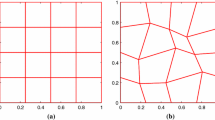Abstract
Based on the Helmholtz decomposition of the transverse shear strain, Brezzi and Fortin in [5] introduced a three-stage algorithm for approximating the Reissner–Mindlin plate model with clamped boundary conditions and established uniform error estimates in the plate thickness. The first- and third-stage involve approximating two simple Poisson equations and the second-stage approximating a perturbed Stokes equation. Instead of using the mixed finite element method which is subject to the inf–sup condition, we consider a stabilized finite element approximation to such perturbed Stokes equations. Optimal error estimates independent of thickness of the plate are obtained for such equations. Then error analysis is established for the whole system.
Similar content being viewed by others
References
D.N. Arnold and R.S. Falk, A uniformly accurate finite element method for the Reissner–Mindlin plate, SIAM J. Numer. Anal. 26(6) (1989) 1276–1290.
D.N. Arnold and R.S. Falk, Asymptotic analysis of the boundary layer for the Reissner–Mindlin plate model, SIAM J. Math. Anal. 27(2) (1996) 486–514.
J.H. Bramble, R.D. Lazarov and J.E. Pasciak, A least-squares approach based on a discrete minus one inner product for first order system, manuscript.
J.H. Bramble and T. Sun, A negative-norm least squares method for Reissner–Mindlin plates, Math. Comp. 67(223) (1998) 901–916.
F. Brezzi, K. Bathe and M. Fortin, Mixed interpolated elements for Reissner–Mindlin plates, Internat. J. Numer. Methods Engrg. 28(1989) 1787–1801.
F. Brezzi and M. Fortin, Numerical approximation of Mindlin–Reissner plates, Math. Comp. 47(175) (1986) 151–158.
F. Brezzi, M. Fortin and R. Stenberg, Quasi-optimal error bounds for approximation of shear-stresses in Mindlin–Reissner plate models, Math. Models Methods Appl. Sci. 1(1991) 125–151.
F. Brezzi, L. Franca, T. Hughes and A. Russo, Stabilization techniques and subgrid scales capturing, in: The State of the Art in Numerical Analysis, York, 1996, The Institute of Mathematics and its Applications Conference Series. New Series, Vol. 63(Oxford Univ. Press, New York, 1997) pp. 391–406.
Z. Cai and J. Douglas, Jr., Stabilized finite element methods with fast iterative solution algorithms for the Stokes problem, Comput. Methods Appl. Mech. Engrg. (1998).
Z. Cai, X. Ye and H. Zhang, Least squares finite element approximations for the Reissner–Mindlin plate, Numer. Linear Algebra Appl., to appear.
P.G. Ciarlet, The Finite Element Method for Elliptic Problems (North-Holland, New York, 1978).
L.P. Franca and R.Stenberg, A modification of a low-order Reissner–Mindlin plate bending element, in: The Mathematics of Finite Elements and Applications VII, ed. Whiteman (Academic Press, New York, 1991) pp. 425–436.
V. Girault and P.A. Raviart, Finite Element Methods for Navier–Stokes Equations: Theory and Algorithms (Springer, New York, 1986).
X. Ye, A rectangular element for the Reissner–Mindlin plate, Numer. Methods Partial Differential Equations, to appear.
Author information
Authors and Affiliations
Rights and permissions
About this article
Cite this article
Ye, X. Stabilized finite element approximations for the Reissner–Mindlin plate. Advances in Computational Mathematics 13, 375–386 (2000). https://doi.org/10.1023/A:1016693613626
Issue Date:
DOI: https://doi.org/10.1023/A:1016693613626




